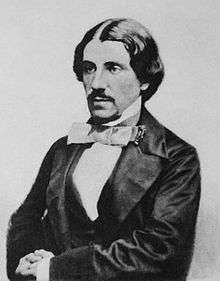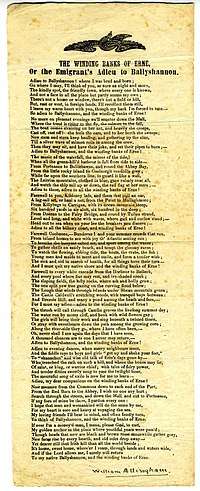William Allingham
William Allingham (19 March 1824 – 18 November 1889) was an Irish poet, diarist and editor. He wrote several volumes of lyric verse, and his poem 'The Faeries' was much anthologised; but he is better known for his posthumously published Diary,[1] in which he records his lively encounters with Tennyson, Carlyle and other writers and artists. His wife, Helen Allingham, was a well-known watercolourist and illustrator.[2]
William Allingham | |
|---|---|
 | |
| Born | 19 March 1824 |
| Died | 18 November 1889 (aged 65) Hampstead, London |
| Nationality | Irish[lower-alpha 1] |
| Occupation | poet, scholar |
| Spouse(s) | Helen Paterson Allingham (1874–1889) |
Biography
William Allingham was born on 19 March 1824 in Ballyshannon, a small town in the south of County Donegal in Ulster in the north of Ireland; he was the son of the manager of a local bank who was of English descent.[3] His younger brothers and sisters were Catherine (born 1826), John (born 1827), Jane (born 1829), Edward (born 1831, and lived only a few months) and a still-born brother (born 1833). During his childhood his parents moved twice within the town, where the boy enjoyed the country sights and gardens, learned to paint and listened to his mother's piano-playing. When he was nine, his mother died.[4]

He was educated at the Royal Belfast Academical Institution until the age of 14,[5] when he obtained a post in the custom-house of his native town, and held several similar posts in Ireland and England until 1870.[6] During this period were published his Poems (1850; which included his well-known poem, 'The Fairies') and Day and Night Songs (1855; illustrated by Dante Gabriel Rossetti and others). (Rossetti's Letters to Allingham (1854–1870), edited by Dr. Birkbeck Hill, were published in 1897.) Laurence Bloomfield in Ireland, his most ambitious, though not his most successful work, a narrative poem illustrative of Irish social questions, appeared in 1864.[6] He also edited The Ballad Book for the Golden Treasury series in 1864, and Fifty Modern Poems in 1865.
In April 1870 Allingham retired from the customs service, moved to London and became sub-editor of Fraser's Magazine, eventually becoming editor in succession to James Froude in June 1874, a post he would hold till 1879.[7] On 22 August 1874 he married the illustrator, Helen Paterson, who was twenty-four years younger than he. His wife gave up her work as an illustrator and would become well known under her married name as a water-colour painter.[6] At first the couple lived in London, at 12 Trafalgar Square, Chelsea, near Allingham's friend, Thomas Carlyle, and it was there that they had their first two children: Gerald Carlyle (born 1875 November) and Eva Margaret (born 1877 February). In 1877 appeared Allingham's Songs, Poems and Ballads. In 1881, after the death of Carlyle, the Allinghams moved to Sandhills near Witley in Surrey, where their third child, Henry William, was born in 1882. At this period Allingham published Evil May Day (1883), Blackberries (1884) and Irish Songs and Poems (1887).
In 1888, because of William's declining health, they moved back to the capital, to the heights of Hampstead village. But in 1889, on 18 November, William died at Hampstead. According to his wishes he was cremated. His ashes are interred at St. Anne's church in his native Ballyshannon.
Posthumously Allingham's Varieties in Prose was published in 1893. William Allingham A Diary, edited by Mrs Helen Allingham and D. Radford, was published in 1907. It contains Allingham's reminiscences of Alfred Tennyson, Thomas Carlyle and other writers and artists.
Assessment and influence
Working on an un-ostentatious scale, Allingham produced much lyrical and descriptive poetry, and the best of his pieces are thoroughly national in spirit and local colouring.[6] His verse is clear, fresh, and graceful. His best-known poem remains his early work, "The Faeries".[8]
Allingham had a substantial influence on W.B. Yeats;[9] while the Ulster poet John Hewitt felt Allingham's impact keenly, and attempted to revive his reputation by editing, and writing an introduction to, The Poems of William Allingham (Oxford University Press/ Dolmen Press, 1967). Allingham's wide-ranging anthology of poetry, Nightingale Valley (1862) was the inspiration for the 1923 collection Come Hither by Walter de la Mare.[10]
We daren't go a-hunting/For fear of little men... was quoted by the character of The Tinker near the beginning of the movie Willy Wonka & the Chocolate Factory, as well as in Mike Mignola's comic book short story Hellboy: The Corpse, plus the 1973 horror film Don't Look in the Basement. The lines Up the airy mountain/Down the rushy glen... form part of the character Magrat's internal monologue in the Discworld novel Lords and Ladies. Several lines of the poem are quoted by Henry Flyte, a character in issue No. 65 of the Supergirl comic book, August 2011. This same poem was quoted in Andre Norton's 1990 science fiction novel Dare To Go A-Hunting (ISBN 0-812-54712-8).
Up the Airy Mountain is the title of a short story by Debra Doyle and James D. Macdonald; while the working title of Terry Pratchett's The Wee Free Men was "For Fear of Little Men".
The Allingham Arms Hotel in Bundoran, Co. Donegal is named after him.[11]
See also
Notes
- Ireland, was within the United Kingdom of Great Britain and Ireland during his lifespan.
References
- William Allingham: a Diary; edited by H. Allingham and D. Radford (1907 and reprints)
- I. Ousby ed., The Cambridge Guide to Literature in English (1995) p. 18
- D. Daiches ed., The Penguin Companion to Literature 1 (1971) p. 19
- H. Allingham and D. Radford (eds), William Allingham, A Diary (1907)
- Robb, John (1913). The Book of the Royal Belfast Academical Institution. Belfast: McCaw, Stevenson & Orr. p. 170.
-

- I. Ousby ed., The Cambridge Guide to Literature in English (1995) p. 18
- The Fairies, multimedia eBook.
- D. Daiches ed., The Penguin Companion to Literature 1 (1971) p. 19
- T Whistler, Imagination of the Heart (1993) p. 322
- "Allingham Arms Hotel | Bundoran". Allinghamarmshotel.ie. 21 November 2013. Retrieved 1 April 2014.
Further reading
- M. McClure, 'Biographical Note: the Allinghams of Ballyshannon', in Donegal Annual; 52 (2000), p. 87–89
- M. S. Lasner, 'William Allingham. Some Uncollected Authors LVI Part 1 (2)', in Book Collector; 39 (1991 summer, autumn), p. 174–204 and 321–349
- S. A. Husni, William Allingham An Annotated Bibliography (1989)
- A. Warner, 'William Allingham Bibliographical Survey', in Irish Book Lore; 2 (1976), p. 303–307
- P. M. England, 'The Poetry of William Allingham' [M.A. thesis, Birmingham University] (1976)
- A. Warner, William Allingham (1975)
- H. Shields, 'William Allingham and folk song', in Hermathena; 117 (1974), p. 23–36
- A. Warner, William Allingham An Introduction (1971)
- W.I.P. McDonough, 'The Life and Work of William Allingham' [PhD thesis, Trinity College, Dublin] (1952)
- P.S. O'Hegarty, 'A Bibliography of William Allingham', in Dublin Magazine (1945 Jan–Mar and July–September)
- J. L. Donaghy, 'William Allingham', in Dublin Magazine; 20:2 (1945), p. 34–38
- H. Knopf, 'William Allingham und seine Dichtung im Lichte der irischen Freheitsbewegung' [Dissertation] (1928. Biel)
- Letters to William Allingham, ed. H. Allingham (1911)
- William Allingham, William Allingham A Diary, ed. H. Allingham and D. Radford (1907)
- D. G. Rossetti, The Letters of Dante Gabriel Rossetti to William Allingham 1854–1870, ed. G.B.N. Hill (1897)
External links
| Wikisource has original works written by or about: William Allingham |
| Wikiquote has quotations related to: William Allingham |
- "Archival material relating to William Allingham". UK National Archives.

- Works by William Allingham at Project Gutenberg
- Works by or about William Allingham at Internet Archive
- Works by William Allingham at LibriVox (public domain audiobooks)

- William Allingham at University of Toronto Libraries
- William Allingham at Library of Congress Authorities, with 41 catalogue records